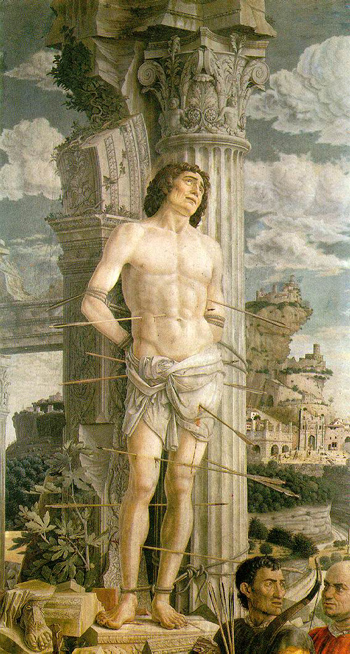| Search Art Prints | ||||||||||||||||||||
| Search Artists | ||||||||||||||||||||

|
||||||||||||||||||||
|
|
|||||||||||||||||||

St. Sebastian

|
St. Sebastian
Andrea Mantegna demonstrated his remarkable skill in conveying perspective and his passion for historic ruins when he created ‘St. Sebastian’ in 1480. The painting displays an older Sebastian being executed for his betrayal of the Emperor Diocletian. Sebastian did not inform the Emperor of his religious beliefs when he was appointed Captain of the Roman Praetorian Guards and, in his new powerful position, he converted many of Diocletian’s followers to Christianity. One of his converts was a jailor who freed many Christians and slaves, hence entailing the rage of the Emperor.
St. Sebastian, tied to an ancient pillar, suffers from his wounds while the executioners near his feet are engaged in what appears to be casual conversation. The arrows that pierced Sebastian’s body were shot from both sides, contrary to the traditional depiction of this famous execution, whereby the arrows are said to have been shot from the front. In the background, Andrea Mantegna placed a magnificent castle atop a rough and serrated cliff that overlooks ancient architecture and lush foliage. At the bottom left of the composition, a foot; a remnant from an old sculpture is believed to have once been a statue of the saint himself.
Analysis
“The picture shows Mantegna’s perfectionist love of detail, which gave his work its admirably finished appearance but entailed slow, painstaking work. This could indicate the influence of Flemish painting, examples of which Mantegna may have seen in Ferrara as a young man. Although the use of oil paint was spreading, Mantegna preferred tempera on canvas, a refined technique whose matt effects are similar to fresco and enhance his incisive drawing, and whose opacity accentuates forms and the severity of the color. The result is close to etching, which Mantegna practiced between 1470 and 1485. The mineral coldness of the forms also evokes sculpture, the major art of the Renaissance, and Squarcione reproached his former pupil because “his paintings did not resemble living models but antique statues.”” – Séverine Laborie (Musée du Louvre)
‘St. Sebastian’ by Andrea Mantegna is located at the Musée du Louvre in Paris, France.











